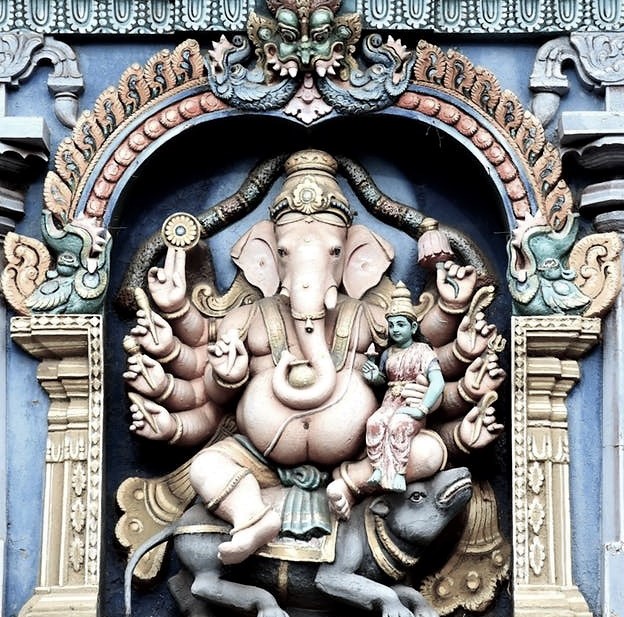- Special FeaturesFoundation YearHoysala Vishnuvardhana - 12th-centurySthala TreeTheerthamRathamArchitectureHoysala ArchitectureOther SpecialityHistorians have found 118 inscriptions in the temple complex
- Sthala Puran
The Hoysala period of South Indian history began about 1000 CE and continued through 1346 CE. In this period, they built around 1,500 temples in 958 centerss. Belur is called Beluhur, Velur, or Velapura in old inscriptions and medieval era texts. It was the early capital of the Hoysala kings. The city was so esteemed by the Hoysalas that it is referred to as "earthly Vaikuntha" (Vishnu's abode) and "Dakshina Varanasi" (southern holy city of Hindus) in later inscriptions.
One of the Hoyasala kings was Vishnuvardhana, who came to power in 1110 CE. He commissioned the Chennakeshava temple dedicated to Vishnu in 1117 CE after an important military victory in 1116 CE. A great devotee of Lord Vishnu, who is also a pious King, who has the name of Lord Vishnu in him, Sri Vishnuvardhana built this temple to mark his conversion to Sri Vaishnavism after coming under the influence of Ramanuja but states Shadakshari Settar, the historical records do not support this theory.
The Chennakeshava temple at Belur took 103 years to build. Vishnuvardhana moved his capital to Dvarasamudra (now called Halebidu), where he started the construction of the Hoysaleswara Temple dedicated to Shiva. Its construction continued till he died in 1140 CE. His legacy was continued by his descendants, who completed the Hoysaleswara Temple in 1150 CE and the Chennakesava Temple, Somanathapura, in 1258 CE. The Hoysalas employed many noted architects and artisans who developed a new architectural tradition, which art critic Adam Hardy called the Karnata Dravida tradition.
The Hoysala Empire and its capital was invaded, plundered, and destroyed in the early 14th century by Malik Kafur, a commander of the Delhi Sultanate ruler Alauddin Khalji. Belur and Halebidu became the target of plunder and destruction in 1326 CE by another Delhi Sultanate army. The territory was taken over by the Vijayanagara Empire. The Hoysala style, states James C. Harle, came to an end in the mid 14th century when King Ballala II was killed in a war with the Muslim army led by Malik Kafur.
- Architecture
Inscriptions:
- Historians have found 118 inscriptions in the temple complex, dated between 1117 CE to the 18th century, which provide a history of the temple, the grants made to the Chennakeshava temple for its upkeep and the repairs during later times.
- An inscription found on the east wall near the north entrance of the temple's main mandapa (hall) states that Vishnuvardhana commissioned the temple for god Vijayanarayana in 1117 CE. Some historians have interpreted this inscription as stating that the Chennakeshava Temple was completed in 1117 CE.
- The Chennigaraya temple was built concurrently with the main temple, and the queen sponsored it.
- Narasimha I of Hoysala dynasty made grants to the temple for its maintenance and operation.
- Ballala II in 1175 CE added temple buildings for kitchen and grain storage in the southeast corner, and a water tank in the northeast corner of the temple.
- The original temple was without boundary wall. The main mandapa was also open for the devotees to view and appreciate the intricate carvings inside the temple. For security of the temple, a high wall was constructed around the temple, a wood-and-brick gateway and doors added by Somayya Danayaka during the rule of Veera Ballala III (1292–1343), as well as the open mandapa was covered with perforated stone screens. The new screens darkened the inside of the temple making it difficult to see the artwork but allowed enough light for the darshana of the garbha griya.
- The temple was raided, damaged and its gateway was burnt down in a raid by a Muslim general Salar and his army working for Muhammed bin Tughlaq (1324-1351).
- The temple was repaired by the Vijayanagara Empire under the sponsorship of Harihara II (1377–1404). In 1381, they added four granite pillars; in 1387, a gold plated kalasa was added by Malagarasa to a new tower above the sanctum; it added a new seven storey brick gopurum in 1397 replacing the destroyed gateway.
- An Andal shrine, the Saumyanayaki shrine, the dipa-stambha at the entrance, the Rama and Narasimha shrines were added during the Vijayanagara Empire era.
- The main temple had a shikara (superstructure tower) but it is now missing and the temple looks flat. The original tower, suggest the inscriptions, was made of a combination of wood, brick and mortar. It was destroyed and rebuilt several times.
- The Vijayanagara Empire sponsored the addition of smaller shrines dedicated to goddesses and the Naganayakana mandapa within the temple complex. These were constructed by collecting the war ruins of other demolished temples in Belur area and reusing them.
- The temple premises were again damaged after the destruction of Vijayanagara Empire by a coalition of Sultanates. The first repairs were done in 1709, followed by additions in 1717 and 1736. The temple was repaired in 1774 by an officer of Hyder Ali during a period when Hyder Ali was the de facto ruler on behalf of the Wadiyar dynasty.
- In late 19th-century, the collapsing tower above the sanctum was removed to save the lower levels and never replaced. In 1935, parts of the temple was cleaned and restored with financing by the Mysore government and grants by the Wadiyar dynasty. The Chennigaraya shrine was rebuilt, new images of Ramanuja and Garuda added along with many other facility improvements and repairs to the complex. These repairs were inscribed in stone for a historical record, just like earlier inscriptions.
- Alankar of Deity
- Prayers and BenefitsSpecial Vratas and PrayersOfferings to DeityStotras and Mantras
- Festivals
- Sodasha Upcharas
- Prasadhas
- Social ActivitiesAnnadhanMarriageEar BoringHead ShaveDanaasEducation FacilitiesSocial DrivesOther Activities
- Arjita Seva
- Tags

